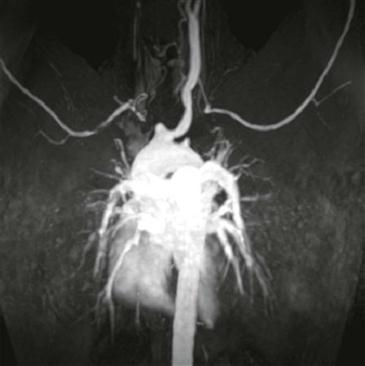CASE 101

1. Which arteries are occluded? (Choose all that apply.)
A. Aorta
2. Which vessel reconstitutes the occluded artery on the left?
3. What is the most likely diagnosis?
ANSWERS
References
Bitar R, Gladstone D, Sahlas D, et al. MR angiography of subclavian steal syndrome: pitfalls and solutions. AJR Am J Roentgenol. 2004;183(6):1840–1841.
Van Grimberge F, Dymarkowski S, Budts W, et al. Role of magnetic resonance in the diagnosis of subclavian steal syndrome. J Magn Reson Imaging. 2000;12(2):339–342.
Vummidi D, Reddy GP. Subclavian steal syndrome. In: Ho VB, Reddy GP, eds. Cardiovascular Imaging. St Louis: Saunders; 2010.
Comment
Clinical Features
Subclavian steal phenomenon is characterized by stenosis or occlusion of the subclavian artery and reversal of flow in the vertebral artery, reconstituting the subclavian artery. Etiologies include atherosclerosis and Takayasu arteritis. Neurologic symptoms are unusual, but when they occur, the diagnosis is subclavian steal syndrome. Neurologic symptoms include lightheadedness, dizziness, upper extremity numbness, and transient ischemic attacks. Subclavian steal syndrome rarely results in stroke.
Imaging
The diagnosis can be made with Doppler ultrasound, which reveals reversal of flow in the vertebral artery. MRI and CT can show the stenotic or occluded vessels and the subclavian artery reconstitution (Figure). Phase contrast MRI and time-of-flight magnetic resonance angiography (MRA) can identify the reversal of blood flow in the vertebral artery.
Treatment
Subclavian steal phenomenon without neurologic symptoms does not require treatment, and patients generally have a benign course. Treatment of subclavian steal syndrome is aimed at fixing the subclavian artery stenosis or occlusion. At the present time, revascularization with balloon angioplasty and stent placement is the treatment of choice. Extrathoracic bypass surgery and endarterectomy are occasionally performed. Medical therapy alone is not used in the treatment of subclavian steal syndrome.







